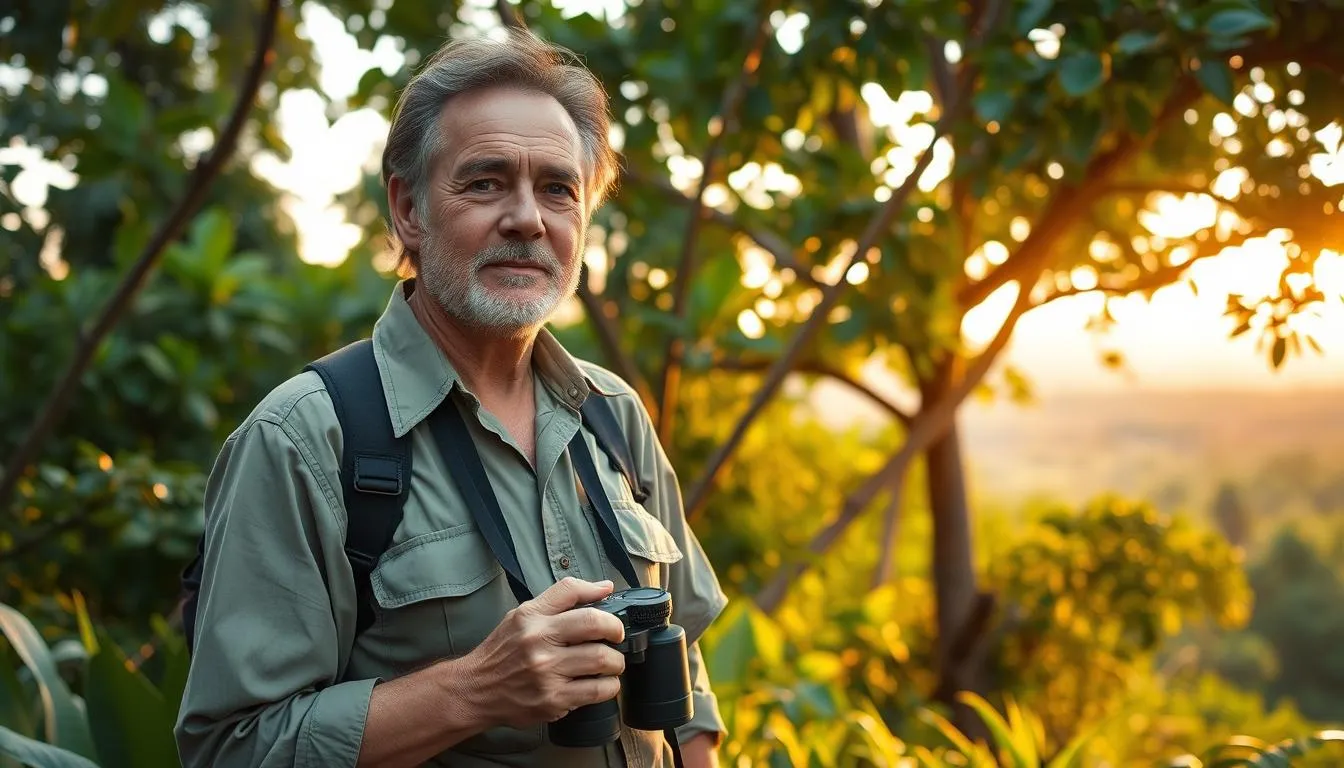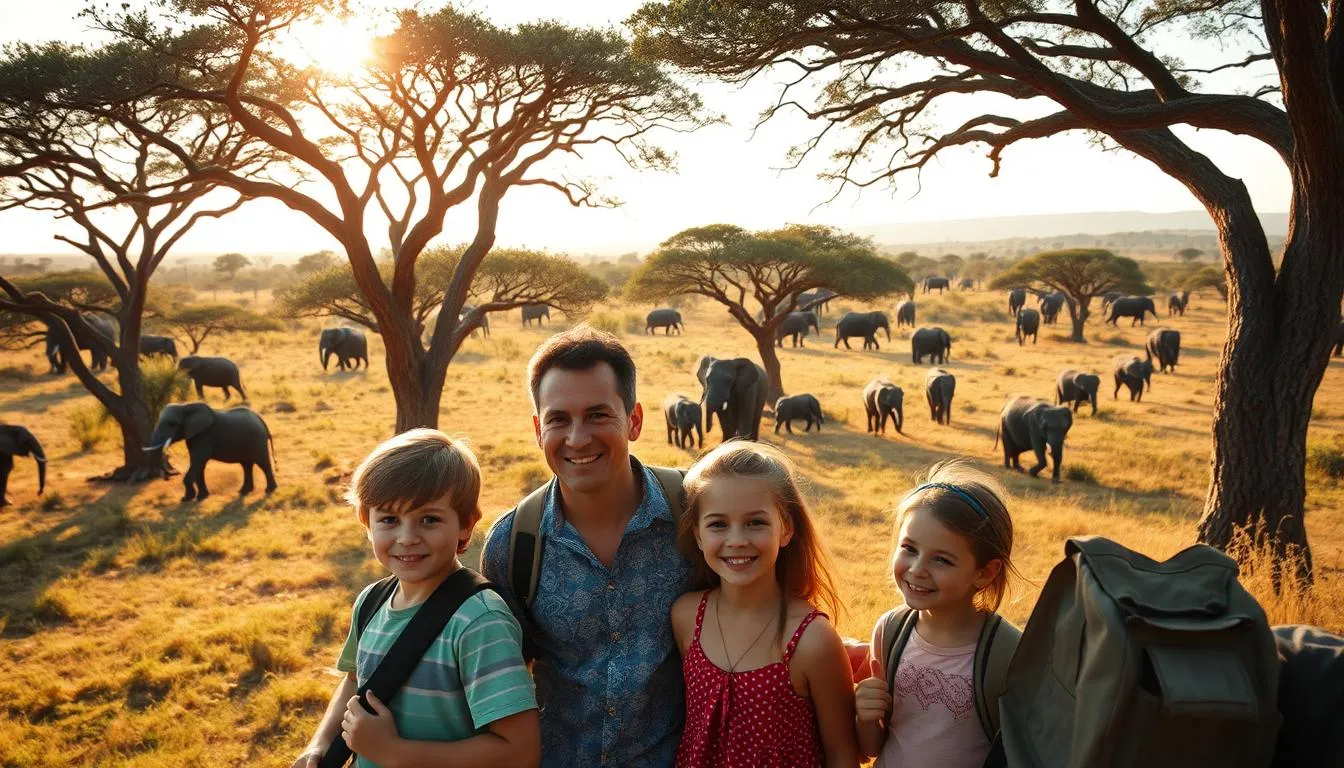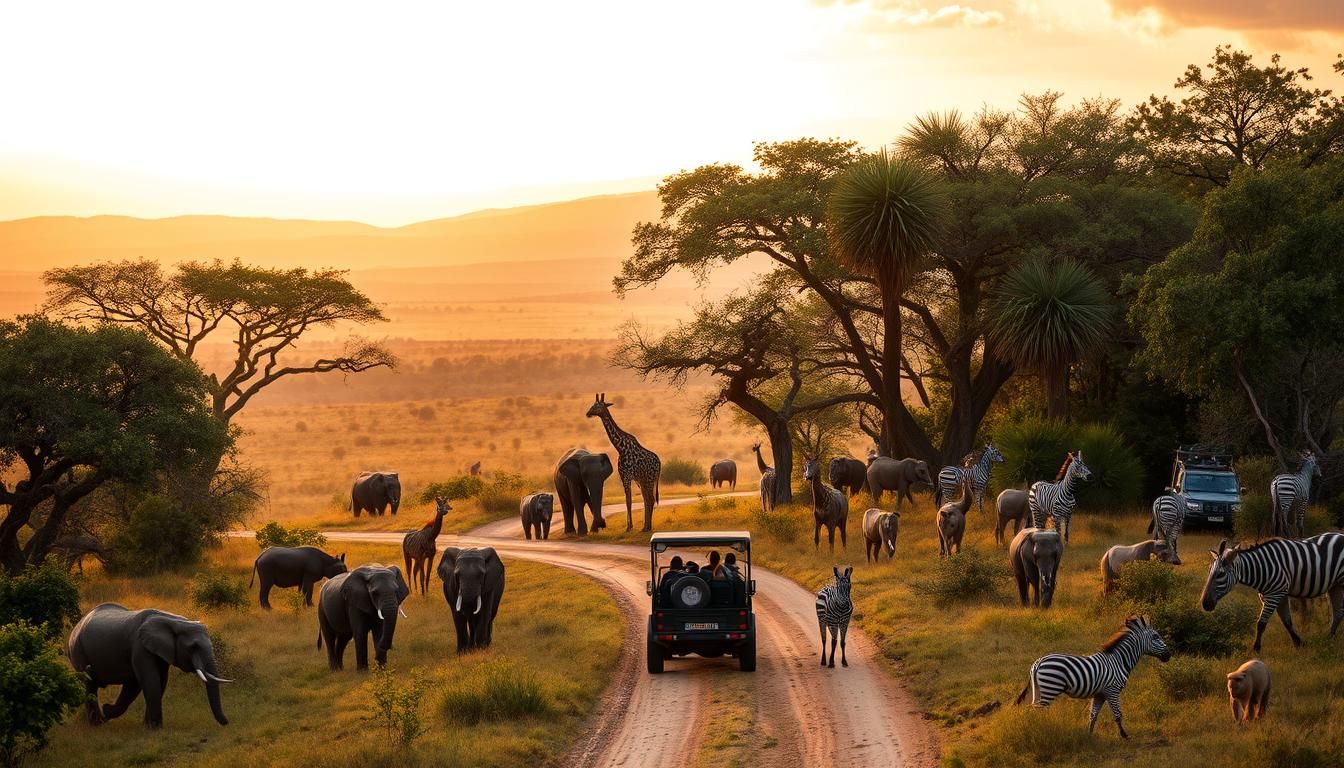Did you know that small-group trips on private reserves increase memorable sightings by over 40%? That shift in approach makes a big difference for people who want both thrill and comfort.
We curate safaris that balance authentic immersion with relaxed luxury. Natural Habitat Adventures focuses on small groups and top-tier Expedition Leaders.
Natural World Safaris brings specialist-led tours across 40+ destinations and a strong primate heritage. Every trip is guided by a seasoned professional who values safety, respect for animals, and smooth logistics.
Expect intimate camps, private reserve access, and unhurried pace so you get meaningful encounters instead of rushed checklists. We match each destination to your interests—big-cat action, primates, birds, or dramatic landscapes—so your experience feels tailor-made from the first call.
Key Takeaways
- Small groups and private departures reduce crowding and boost viewing quality.
- Expert guides ensure safety, respect for animals, and smooth tour logistics.
- We pair destinations to your interests for a personalized trip.
- Private reserves and intimate camps create deeper, unhurried experiences.
- Pre-departure guidance covers visas, health, gear, and photography tips.
Welcome to Unforgettable Wildlife Safaris, Crafted for Nature Lovers
Join intimate departures that favor quality encounters over crowded itineraries. Our design keeps each group small so all guests get prime viewing spots, more time with animals, and the flexibility to linger when behavior gets exciting.
Small groups, big experiences: what sets our safaris apart
Capping trips at 6–14 people means quicker rollouts at first light and smooth coordination at sightings. Vehicles hold fewer people so everyone moves for the best angle and no one misses the moment.
We handpick camps placed near corridors and waterholes. You get hot showers, fine dining, and attentive service while staying close to nature with low-impact practices that support conservation.
Expert-led adventures with comfort in the wilderness
From Natural Habitat Adventures’ Expedition Leaders to Natural World Safaris’ specialists, our guides bring field experience, local relationships, and sharp tracking skills that make each tour a rich learning journey.
Personalized attention is standard. Guides and camp teams help with camera settings, mobility needs, or animal targets. Evenings bring guide talks, storytelling around the fire, and shared photos—simple rituals that turn an adventure into lasting memories.
- Prime viewing: capped groups for better sightlines.
- Local expertise: specialist guides and tracking skills.
- Responsible camps: low-impact, conservation-minded operations.
“Small groups, expert teams, and thoughtful camps let you focus on what matters: real encounters and meaningful learning.”
Private and custom options are available for families, friends, or photographers who want a fully tailored pace and focus. Continue to the next section to learn why our guides and camps deliver exceptional wildlife moments.
Why Choose Our Guides and Camps for Exceptional Wildlife Viewing
Our leaders combine fieldcraft and local knowledge to turn every sighting into a learning moment.

Highly trained Expedition Leaders and specialist safari guides
Top guides read tracks, predict movement, and position vehicles for natural behavior. They keep safe, ethical distances that still deliver powerful wildlife experiences.
We partner with operators whose training matches the industry’s best. That includes advanced tracking, first-aid, and photographic guiding skills.
Private reserves and secluded camps for crowd-free encounters
Private reserves mean fewer vehicles, off-road allowances where permitted, and flexible night drives in select areas. That results in calmer sightings and richer game viewing.
Camps sit near waterholes or migration routes so guests often see activity from their veranda or during short drives.
Luxury amenities in remote locations for a seamless experience
Expect ensuite tents, premium bedding, battery charging stations, and refined meals. Camp teams are ready on return with refreshments, camera cloths, and updates on nearby game.
- Small vehicles with fewer guests per row for better sight lines.
- Radio networks and vetted lodges support quick, respectful responses to sightings.
- Ethical guiding underpins every decision to protect animal welfare.
| Feature | Benefit | Where it Applies | Why it Matters |
|---|---|---|---|
| Expedition Leaders | Advanced tracking, photography tips | Private reserves, top camps | More meaningful, safer encounters |
| Secluded Camps | Prime locations near water | Floodplains, riverine forests | Action often visible from camp |
| Small Vehicles | Better sight lines, personal commentary | All game drives | Enhanced learning and photos |
| Luxury Services | Ensuite tents, hot meals, charging | Remote areas | Comfort complements the wild |
“Ethical guiding and top-tier camps create the space for real encounters and lasting memories.”
Signature Destinations for World-Class Wildlife Sightings
From delta waterways to highland forests, our route connects places with consistent sightings and dramatic landscapes.
Southern Africa: Botswana, South Africa, Namibia, Zambia
Expect a classic botswana safari through the Okavango Delta’s channels and predator-rich Linyanti plains. Zambia offers river systems and a walking-safari heritage that changes how you track animals.
In south africa, private reserves deliver concentrated viewing with fewer vehicles. Namibia’s Etosha and the Skeleton Coast showcase desert-adapted species and stark scenery.
East Africa: Kenya, Tanzania, Uganda, Rwanda
Kenya’s Maasai Mara and adjoining conservancies pair with Tanzania’s Serengeti and Ngorongoro Crater for iconic migration and big-cat action.
Uganda and Rwanda are primate strongholds where mountain gorilla treks create life-changing moments. Seasonal windows help you match timing to your goals.
Indian Ocean & Islands: Madagascar’s endemic species
Madagascar offers lemurs, rare reptiles, and striking birds across rainforests, spiny desert, and coastlines. These locations are ideal for photographers and naturalists seeking island endemics.
Iconic national parks and conservancies on our route
We favor private conservancies and less-crowded national park zones to improve sighting quality and guide flexibility during drives.
“We balance marquee parks with quieter conservancies to offer both iconic scenes and intimate moments.”
- Accommodation sits close to productive habitat to maximize dawn and dusk drives.
- Combining countries—like Botswana with Zambia or Kenya with Tanzania—creates rich biodiversity arcs.
- Birders can expect prolific raptors and waterbirds in wet seasons; dry months concentrate game around water.
Call our team to match specific destinations to your wish list—big cats, elephants, rhinos, wild dogs, primates, or rare island species.
Trip Styles: From Family Adventures to Pro Photo Expeditions
Choose the trip style that fits your group—whether a family escape or a focused photography expedition. We design options so every guest enjoys the pace, comfort, and learning moments they want. Options range from playful, kid-friendly stays to camera-led departures for serious shooters.

Family-friendly camps and activities for all ages
Family camps offer flexible mealtimes, child-friendly guide talks, and junior ranger programs that keep kids curious and parents relaxed.
We advise minimum ages and pick camps close to productive areas for quick drives. Safety, engaging storytelling, and tailored activities turn each drive into a shared lesson.
Photo Expeditions with doors-off helicopter options
Photo trips run in small groups (often 6–8 guests) and include special support: beanbags, power for charging, and pro photographers who coach composition and camera settings in the field.
Natural Habitat Adventures and Natural World Safaris operate specialist departures. In select Botswana programs, doors-off helicopter flights give unparalleled aerial views timed for the best light.
Custom and private itineraries tailored to your group
Private itineraries let your group set the pace—early starts, extended golden-hour stops, or extra dusk time where regulations allow. We match guides to your style: photographers, birders, or big-mammal trackers.
- We arrange dietary, mobility, and gear needs in advance so camps are briefed and days run smoothly.
- Sample formats include a week in Botswana lagoons for photography, a mixed Kenya–Tanzania big-cat focus, or a primate-centric family trip with gentle hikes.
Contact our team to plan a private departure timed for school holidays, long weekends, or migration river crossings and make your wildlife safari truly yours.
Seasonality and Timing: Plan Your Safari by Month and Migration
Timing your trip around seasonal peaks makes the difference between fleeting views and unforgettable encounters.
Green season vs. dry season: how viewing changes
The green season (Nov–Mar in parts of Botswana) brings lush landscapes, dramatic skies, and many newborns. Birdlife is vibrant and photography shows saturated colors.
Dry months concentrate animals near water and thin vegetation improves visibility. Predators are easier to find and big herds gather at predictable water sources.
Great Migration windows across Kenya and Tanzania
The migration follows rainfall. Herds calve in the southern Serengeti Dec–Feb, move north Mar–Jun, and reach Kenya’s Maasai Mara around Jul–Sep/Oct.
Tanzania runs special migration departures Dec–Feb and Jul–Oct; Kenya’s prime months are Jul–Sep. Exact route shifts with rains, so flexibility matters.
Best time for gorilla trekking in Uganda and Rwanda
Gorilla permits operate year-round. Many guests pick drier months for steadier trails, but mist and cloud can add atmosphere for photos.
“Build in buffer days — weather, water levels, and park rules can change plans, and a flexible schedule preserves must-see moments.”
- Choose by goal: dry season for predator action; green season for newborns and dramatic storms.
- Route planning: we sequence camps to follow movements and book seasonally positioned or mobile camps.
- Timing tips: early departures and late returns maximize viewing; midday is good for rest or hides.
Low-season travel can mean fewer vehicles, softer light, and better rates. For month-by-month guidance, check our detailed planning page: plan by month.
Sample Itineraries and Days on Safari
A well-paced 9–12 day itinerary stitches together two to three top areas so you see more and travel less. This approach reduces internal flights and gives longer drive times in each location.
Classic 9–12 day journeys typically blend nearby regions—like Okavango channels and Kalahari dunes or private reserves in South Africa—to deliver contrasting scenery and sustained viewing opportunities.
Classic 9–12 day journeys across premier areas
Most sample trips run 9–12 days with two to three nights per camp. That pacing helps you learn an area’s rhythms and return to follow up on developing sightings.
Examples include 9 Days in Botswana’s Okavango and Kalahari, 10 Days across South Africa’s private reserves, and 12 Days for a deeper Botswana circuit. Many itineraries offer Victoria Falls add-ons or primate extensions.
Typical day and evening wildlife viewing hours
A standard day starts pre-dawn for peak activity, then a long morning drive. Midday is for rest, meals, or optional hide time.
Afternoon outings return for golden-hour light. Evening hours, where permitted, reveal nocturnal predators and smaller mammals, expanding what you see in a single day.
Extensions to Victoria Falls, mountains, and coastal habitats
Consider adding Victoria Falls between Botswana and Zambia, mountain regions for hiking, or coastal time for marine life and beaches. Primate add-ons in Uganda or Rwanda are perfect after an East Africa big-game circuit.
- Tip: Internal flights minimize backtracking; pilots and ground teams coordinate smooth handoffs.
- Tip: Use layover days at start or end as cushions for flight changes and jet lag.
- Customize: Add private vehicles, extra hours in the field, or specialist birding walks to tailor your tour.
“Two to three nights per camp lets you follow animal movements and build familiarity with each destination.”
For sample day-by-day examples in East Africa, see a focused 7–10 day Tanzania itinerary to compare pacing and options.
Access, Safety, and Guest Comfort on Safari
We plan so that accessibility, weather, and animal welfare never surprise you.
Age guidelines and group size
Family operations often welcome children from ages 3–6, but rules vary by tour. Many providers require anyone under 16 to travel with a responsible adult person for safety and supervision.
Smaller groups mean fewer seats per row, faster stops when behavior intensifies, and more time for the guide to explain sights. That layout improves viewing and keeps the day flowing.
Mobility and accessibility support
Notify us early about mobility, dietary, or medical needs so we can arrange accessible vehicles, seating, or special timing. Some venues ask guests to call ahead for wheelchair spaces or carts—call 619-718-3000 for specific availability.
Viewing can shift with weather, animal movement, or park rules. Guides adapt routes and make real-time changes to keep the day safe and productive.
Many tours run in rain or sun; during severe conditions teams may reroute, reschedule, or cancel with rescheduling efforts. For event status in inclement weather call 619-718-3000.
Service animals and on-vehicle rules
To protect animals and habitats, some parks restrict service animals on wildlife vehicles. When service animals cannot join, we suggest private cultural or botanical activities as alternatives.
Also note many parks bar outside food, selfie sticks, and certain tripods; closed-lid water bottles are recommended for comfort and safety.
“Safety briefings at the start of each tour set expectations for vehicle etiquette, lodge boundaries, and best practices around animals.”
| Item | Why it Matters | Guest Action |
|---|---|---|
| Age limits | Ensures safety and supervision | Confirm ages when booking |
| Small groups | Better sight lines and faster stops | Choose capped departures |
| Accessibility support | Comfortable participation for all | Call ahead to arrange seating |
| Weather & animal movement | Routes change for safety and viewing | Allow flexible timing |
For more on on-foot safety and practical guidance, see our safety and practicalities page.
Booking Confidence: Changes, Cancellations, and Support
Booking with confidence starts when change windows and clear terms match your travel pace. We outline timelines so each person knows when money becomes non-refundable and what support is available if plans shift.

Flexible change windows and how rescheduling works
Most programs allow changes up to a defined window before departure—commonly several days. For example, reservations at San Diego Zoo Safari Park may be changed up to 3 days before the program.
Within that window you can adjust dates, swap a tour, or update guest details. After the deadline, operational commitments limit options because guides, vehicles, and permits are allocated to your trip.
When payment becomes non-refundable and why
Some cancellations made more than a few days out carry a modest administrative fee. San Diego Zoo Safari Park charges $25 for cancellations more than 3 days before a program.
Cancellations received within 3 days are typically non-refundable. That reflects real costs already spent on staff, permits, and logistics.
- Weather or animal-health changes: Tours may be canceled or rerouted; priority goes to moving you to the next suitable slot.
- Support: Our team helps with airline rebookings, documents, and on-the-road questions up to and during the journey.
- Buffer time: Arrive a day early for international flights to reduce risk of missed first days.
“Clear pre-departure communication helps every guest understand deadlines for balances, permits, and special activities.”
| What | Typical Policy | Guest Action |
|---|---|---|
| Change window | Up to 3 days before (varies by supplier) | Request changes early; confirm new dates |
| Cancellation fee | Modest admin fee if >3 days (example: $25) | Check terms at booking |
| Non-refundable period | Within 3 days prior—payment often retained | Buy travel insurance; be certain of dates |
| Provider cancellations | Due to weather or animal health; rescheduling prioritized | Accept alternate slot or credit |
Tip: Purchase travel insurance that covers medical, interruption, and weather-related issues—especially for remote trips. If you have a specific destination or season in mind, contact us to review exact cancellation terms before you pay.
Conservation, Ethics, and Real-World Impact
Conservation is woven into every choice we make, from partners to camp layouts.
Partnering with specialist operators channels real funding into protected areas and community programs. Natural Habitat Adventures works with the World Wildlife Fund and similar groups, while Natural World Safaris emphasizes professional guiding that supports anti-poaching and staff livelihoods.
Field practices that protect habitat and animals
Low-impact rules keep disturbance minimal: strict speed limits, no off-road driving where banned, and caps on vehicles at sightings. Guides teach respectful distancing so animals behave naturally and you get richer photos and quieter experiences.
Community, camp standards, and transparency
Camps invest in solar power, water treatment, and waste reduction to lower their footprint in remote wilderness. Local employment, guiding apprenticeships, and cultural visits build shared stewardship.
“A portion of trip costs supports research and habitat restoration, and updates are shared during camp talks.”
| Action | Benefit | Who it Helps | How to Join |
|---|---|---|---|
| Partnerships with NGOs | Funds anti-poaching and research | Species and parks | Choose partnered departures |
| Low-impact driving | Less stress on animals | Local wildlife and birds | Follow guide briefings |
| Camp sustainability | Reduced footprint | Habitat and community | Support eco-certified lodges |
| Community programs | Local jobs and training | Villages and guides | Attend cultural experiences |
Takeaway: simple traveler choices—reusable bottles, respectful behavior, and sharing responsible stories—amplify conservation beyond the trip.
Wildlife Safaris: Start Your Journey Now
Begin by naming the one moment that would make this trip unforgettable. That goal drives the choice of destination and the right season to visit.
How to choose your destination and ideal season
Start with your must-see animal or behavior, then match it to places and months where it happens most reliably.
Simple decision path: pick the encounter, then the destination, then the season and camp sequence.
Speak with a safari guide to refine your itinerary
Book a short call with a senior guide or planner to convert your wish list into a clear itinerary.
They will balance travel time, camp swaps, and pacing to suit your group and guests’ fitness or camera skills.
- Plan early for peak months to secure scarce camps and specialist guides.
- Add one flexible night in a core area to improve odds for rare behavior.
- We handle flights, transfers, and permits so you can relax and enjoy the journey.
“Share your target species list and photography priorities — we’ll match guides and camps to your goals.”
Contact us today to lock your preferred dates and begin crafting a trip you’ll talk about for years.
Conclusion
A thoughtful route gives you space to follow herds, linger at waterholes, and capture decisive moments without hurry.
Our offering blends expert guides, intimate camps, and smart routing so each day feels purposeful yet relaxed. That mix boosts viewing quality and creates richer encounters across prime national park and private-reserve areas like South Africa and Botswana safari waterways.
Choose from classic trips, family-friendly adventures, mountain primate treks, or photo-led tours tuned to light and behavior. Safety and ethics guide every decision: professional teams, clear park policies, and comfort measures keep animals and people protected.
If you want practical tips or a custom itinerary, ask us. We’ll match season, available days, and your must-see species—then lock dates so you can start counting down to your next great experience. Learn more in our wildlife safari guide.
FAQ
What types of game drives and viewing hours can I expect on a typical day?
Most itineraries include early morning and late afternoon drives when animals are most active. Expect two or three outings a day, each lasting from 2 to 5 hours, plus optional night drives where permitted. Guides tailor timing to local conditions and species activity to maximize sightings and comfort for guests.
How small are the groups and why does that matter?
Groups are intentionally small—often between 4 and 10 people—to reduce disturbance to animals and provide a personalised experience. Smaller groups mean better sightlines, quicker response from guides, and more opportunities for photography and close encounters without crowding the plains.
Are the guides and leaders qualified to ensure safe, informative outings?
Yes. Expedition leaders and specialist guides hold professional qualifications, first aid training, and deep knowledge of local species and habitats. They use proven tracking techniques and follow park rules to keep guests safe while delivering insightful, educational commentary.
Which countries and parks are included on your signature routes?
Signature routes feature premier regions across Southern Africa (Botswana, South Africa, Namibia, Zambia), East Africa (Kenya, Tanzania, Uganda, Rwanda), and select islands such as Madagascar. Routes highlight iconic national parks, private reserves, and conservancies to showcase diverse ecosystems and species.
Can I bring my family or children on these trips?
Yes. We offer family-friendly camps and tailored activities for younger guests. Age guidelines vary by destination and activity—some conservancies require guests to be a minimum age for night drives or walking safaris—so check specific trip details when booking.
What are the best times to see the Great Migration and other seasonal events?
Migration windows shift by year, but peak river crossings in the Maasai Mara and Serengeti typically occur between July and October. Green and dry seasons affect visibility and behavior—dry months concentrate herds around waterholes, while green months offer lush scenery and newborn animals.
How long are the sample itineraries and can they be customized?
Classic journeys run 9–12 days, covering multiple reserves and species-rich areas. We also offer shorter trips, extensions to Victoria Falls or coastal habitats, and fully private itineraries that match your group’s interests, fitness level, and photographic goals.
What accommodation and amenities are provided in remote camps?
Camps range from comfortable tented lodges to luxury camps with hot showers, electricity, and fine dining. Locations prioritize low-impact design while delivering seamless service. Expect comfortable bedding, secure storage, and knowledgeable staff to handle logistics in remote settings.
How do you support conservation and ethical travel in parks and reserves?
We partner with specialist operators, conservancies, and national parks to fund anti-poaching, habitat restoration, and community projects. Our practices emphasize minimal footprint, respectful viewing distances, and local employment to ensure trips benefit ecosystems and people alike.
What should I pack for a camera-ready photo expedition or helicopter door-off flight?
Pack lightweight, layered clothing in neutral tones, a sturdy telephoto lens for wildlife, extra batteries, and protective cases. For doors-off helicopter options, follow operator briefings on helmets, straps, and lens tethering; professional guides help plan shots and safety measures.
Are there accessibility options for guests with limited mobility?
Many camps and vehicles can accommodate mobility needs, and guides adapt activities where possible. Please disclose mobility requirements at booking so teams can arrange suitable accommodations, vehicle access, and assistance in parks with uneven terrain.
How flexible are booking changes and what are the cancellation terms?
We offer flexible change windows on many departures; exact terms vary by operator and season. Payments become non-refundable according to the supplier’s policy—typically closer to departure—so review your itinerary’s cancellation schedule and consider travel insurance for protection.
What health and safety measures are in place, including for service animals?
Guides follow strict safety protocols, first aid procedures, and wildlife-safe policies. Service animals must meet park health and vaccination rules and may be restricted in certain reserves to protect wildlife. Notify us in advance to confirm policies and prepare necessary documentation.
How do I choose the best destination and season for my interests?
Consider target species, terrain, and activity level. For big herds and dramatic migrations choose East Africa in dry months; for quiet, exclusive sightings pick Botswana or private reserves in the dry season; for primates, plan gorilla treks in Rwanda or Uganda during drier windows. Speak with a guide to refine timing and route based on your priorities.
